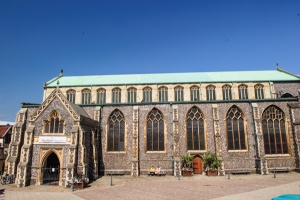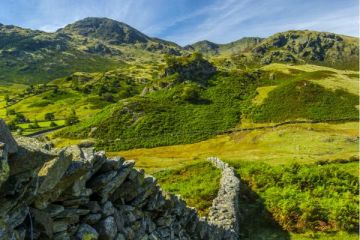
The Halls is a complex of historic flint buildings on St Andrew's Plain, centred around a medieval Dominican friary. The area was first used around 1250 by the Friars de Sacco (The Friars of the Sack), a Mendicant order of brothers. The name comes from the simple robes worn by the brethren, cut from coarse cloth, like sackcloth.
The order was suppressed in 1274, and in 1307 the Dominicans moved here from their friary on Colegate, where they had been since 1226. The Dominicans built a church and accommodation for up to 60 friars. They continued to expand the complex of buildings on the site throughout the 14th century, but in 1413 the friary and church were destroyed by fire.
The Dominicans moved back to their Colegate site while the St Andrew's Plain site was rebuilt, in part with money donated by local benefactors. One of the largest donors was Sir Thomas Erpingham (c.1355-1428), whose son Robert was a friar here.
Erpingham led the English archers at the Battle of Agincourt in 1415 and erected the gate to the cathedral close that bears his name. Look for his coat of arms between the clerestory windows of St Andrew's Hall.
The church was rebuilt on a grand scale, and the friary buildings were ready to move back into by 1449. The entire rebuilding process was not completed until 1470, however. It is this mid to late 15th century complex of buildings that we see today.

St Andrew's Hall
In the early years of the 16th century, an anchoress named Katherine Manne locked herself away in a cell in the friary grounds, expressing a desire to devote herself to prayer and offer spiritual guidance to others
In 1531 a priest named Thomas Bilney gave her a copy of William Tynedale's English translation of the Bible. For this act, Bilney was found guilty of heresy and burned at the stake in Lollard's Pit. (see Norwich Guildhall). The remains of Manne's anchoress cell can be seen outside the north door.
The friary was forced to close when Henry VIII dissolved the monasteries. Most monastic sites closed during the Dissolution became ruins, or were scavenged for building materials. How, then, did The Halls survive?

They survived because of one man, Augustine Steward, Mayor of Norwich. steward appealed to Henry VIII, asking if the City of Norwich could buy The Halls if they used the site for fairs, feasts, and generally for the good of the people of Norwich.
The king agreed, and the friary buildings were saved, though at the sizeable cost of £233. The Halls only cost £81, but the city Chamberlains then had to pay £152 for roofing lead they had already purchased!
The nave of St Andrew's was paved and renamed The New Hall. Its first recorded civic use was for a Mayor's Feast for Henry Fuller in 1544.
The Halls have not always been used for dignified civic functions, however!
In 1549 the Earl of Warwick stabled his horses inside the hall when he came to Norwich to deal with Robert Kett's rebellion. Blackfriar's Hall became the official chapel for the City Council and Guilds. It was used as a school for King Edward VI's Grammar School, which is now located in the Cathedral Close.

It was also used as a church for Flemish refugees from religious persecution in the Low Countries. This was a significant purpose, for a census of 1579 reveals that there were some 6,000 'Dutch' inhabitants out of a total population of 16,000. The final Dutch services were held in 1929.
From 1712-1859 the complex served as the city Workhouse. The Halls continue to be used for a variety of civic functions, and they now hold the largest collection of civic portraits in England. There are over 127 portraits, including Sheriffs, city officials, and mayors from the 16th to the 19th century.
One of the most impressive portraits in Blackfriars is not a civic official, but a full-length painting of Admiral Nelson painted in 1802. This is thought to be one of the last portraits of Nelson painted before his death at Trafalgar three years later. The artist is Sir William Beechey, a friend of Nelson and a member of the Royal Academy.

The layout of The Halls is typical of a Dominican friary. The nave of St Andrew's church was used for preaching to the local population, while the friars held their own services in the chancel, now known as Blackfriar's Hall. Unlike an ordinary parish church, the nave and chancel were kept completely separate, joined only by a walkway which also gave access to a cloister.
The walkway was surmounted by a tower, built in 1462 under the patronage of Simon de Felbrigge, who lies buried in Blackfriars Hall. The tower collapsed in 1712.
The most impressive feature of St Andrew's (the nave) is a 15th-century hammerbeam roof. This was a gift of the powerful Paston family, who maintained a townhouse residence in nearby Elm Hill. The Paston's also gave money for the great 15th century doors in the south porch.
The earliest part of the complex however, is the Thomas a Becket Chapel and the Crypt Coffee Bar. These date from the late 13th century. The chapel is a delight with beautiful brick vaulting rising from a central rounded pillar of stone. The effect is like a brick and stone tree with spreading branches.
The Halls is usually open during daylight hours, but exact times depend on event schedules. Groups can also pre-book tours through the local tourist information centre. There is no charge to see the interior.


About The Halls
Address: St Andrew's and Blackfriars, St Andrew's Plain, Norwich,
Norfolk,
England, NR3 1AU
Attraction Type: Historic Church
Location: At the junction of Princes Street and St George's Street, three blocks north of the castle parking area
Website: The Halls
Email: thehalls@norwich.gov.uk
Location
map
OS: TG231088
Photo Credit: David Ross and Britain Express
NEARBY HISTORIC ATTRACTIONS
Heritage Rated from 1- 5 (low to exceptional) on historic interest
Armada House - 0 miles (Historic Building) ![]()
Norwich, St Michael at Plea - 0.1 miles (Historic Church) ![]()
Hungate Medieval Art - 0.1 miles (Museum) ![]()
Bridewell Museum - 0.1 miles (Museum) ![]()
St George Tombland - 0.1 miles (Historic Church) ![]()
Augustine Steward's House - 0.1 miles (Historic Building) ![]()
Norwich, St John Maddermarket Church - 0.1 miles (Historic Church) ![]()
Erpingham Gate - 0.1 miles (Historic Building) ![]()
Nearest Holiday Cottages to The Halls:
Spixworth, Norfolk
Sleeps: 2
Stay from: £255.00 - 1184.00
More self catering near The Halls



